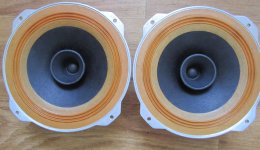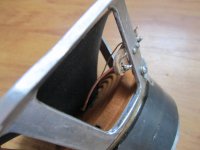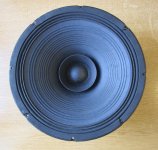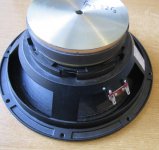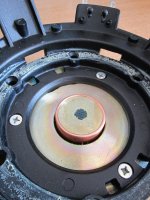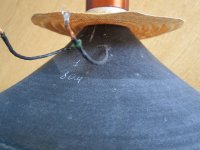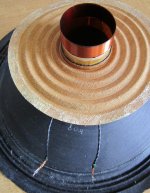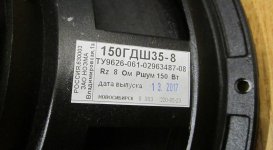TFR8-1-2000, №28, №29.
Thiele-Small parameters, and Impedance Characteristics (in Table)
........Re, Ohm;....Fs, Hz;....Qa;.....Qe;.....Qt....Vas, l.
№28....1500.........58,1.....9,14....0,57...0,54....-
№29....1490.........58,9.....10,1....0,56...0,53....-
Thiele-Small parameters, and Impedance Characteristics (in Table)
........Re, Ohm;....Fs, Hz;....Qa;.....Qe;.....Qt....Vas, l.
№28....1500.........58,1.....9,14....0,57...0,54....-
№29....1490.........58,9.....10,1....0,56...0,53....-
Attachments
Approximately 93 dB/W/m
The band is at a level of - 4 dB at 23 kHz.
Despite the great resistance.
Two users compare sound with planar speakers, as clarity and detail.
We have the direct exit from the cathode of the tubes to the coil of the loudspeaker. No capacitor, no transformer.
The minimum obstacle is to really listen to the direct heating triode.
In addition, the loudspeaker is almost a resistor.
Very rarely 4 or 8 ohm loudspeakers have this kind of impedance characteristics.
I would be very happy if you show similar.
Thank you.
The band is at a level of - 4 dB at 23 kHz.
Despite the great resistance.
Two users compare sound with planar speakers, as clarity and detail.
We have the direct exit from the cathode of the tubes to the coil of the loudspeaker. No capacitor, no transformer.
The minimum obstacle is to really listen to the direct heating triode.
In addition, the loudspeaker is almost a resistor.
Very rarely 4 or 8 ohm loudspeakers have this kind of impedance characteristics.
I would be very happy if you show similar.
Thank you.
Last edited:
Characteristics 12" full range 150ГДШ35 "НОЭМА" after upgrade.
Option with one high-resistance winding.
Nominal resistance 3,6 kOhm, conditional name: "TFR12-1-3600".
......Re, кОм;....Fs, Гц;......Qa;......Qe;.......Qt.....Vas, л.
№1...2,5.........51,0.......6,27.....1,05......0,90.....-
Dependence of impedance on frequency:
Dependence of impedance on frequency:
F, kHz, ...... Z, kOhm
0.15 ......... 2.9
0.2 ........... 2.9 (Zmin)
0.25 ......... 2.95
0.35 ......... 3.0
0.5 ........... 3.3
0.7 ............... 3.45
1.0 ........... 3.6
1.5 ........... 3.8
2 .............. 3.9
4 .............. 4.3
7 .............. 4.5
10 ............ 4.8
15 ............ 4.9
20 ............ 5,5
23 ............ 5.8 (F2z)
31.5 ......... 6.9
35 ............. 7.2
40 ............. 7.2
50 ............. 6.5
60 ............. 5.2
80 ............. 4.4
100 ........... 2.9
150 ........... 2.1
200 ........... 1.8
Despite such a large resistance, the frequency of doubling the minimum resistance (F2z) is outside the audio range, at a frequency of 23 kHz.
That is, the resulted inductance of the voice coil is scanty.
Due to the influence of the internal-winding capacitors, the impedance smoothly reaches the "shelf" of the maximum (7,2 kOhm), at a section of 35-40 kHz.
Inside the speaker there is, as it were, its own RC chain.
The deviation of impedance in the wide range of 150 - 100 000 Hz is only two and a half times.
Option with one high-resistance winding.
Nominal resistance 3,6 kOhm, conditional name: "TFR12-1-3600".
......Re, кОм;....Fs, Гц;......Qa;......Qe;.......Qt.....Vas, л.
№1...2,5.........51,0.......6,27.....1,05......0,90.....-
Dependence of impedance on frequency:
Dependence of impedance on frequency:
F, kHz, ...... Z, kOhm
0.15 ......... 2.9
0.2 ........... 2.9 (Zmin)
0.25 ......... 2.95
0.35 ......... 3.0
0.5 ........... 3.3
0.7 ............... 3.45
1.0 ........... 3.6
1.5 ........... 3.8
2 .............. 3.9
4 .............. 4.3
7 .............. 4.5
10 ............ 4.8
15 ............ 4.9
20 ............ 5,5
23 ............ 5.8 (F2z)
31.5 ......... 6.9
35 ............. 7.2
40 ............. 7.2
50 ............. 6.5
60 ............. 5.2
80 ............. 4.4
100 ........... 2.9
150 ........... 2.1
200 ........... 1.8
Despite such a large resistance, the frequency of doubling the minimum resistance (F2z) is outside the audio range, at a frequency of 23 kHz.
That is, the resulted inductance of the voice coil is scanty.
Due to the influence of the internal-winding capacitors, the impedance smoothly reaches the "shelf" of the maximum (7,2 kOhm), at a section of 35-40 kHz.
Inside the speaker there is, as it were, its own RC chain.
The deviation of impedance in the wide range of 150 - 100 000 Hz is only two and a half times.
Attachments
Last edited:
Wow, that's a serious magnet! It is a very heavy speaker, I imagine.
Good work!
Perhaps this will be the only speaker in the world with such high Z...
A little curiosity...
Some '30 and '40 radios used Hi-Z speaker directly coupled to output stage anode (probably before the Philips famous Hi-Z speakers), but I don't know about it's real impedance, and are small lo-fi speakers.
Like this: Emerson CF255
Good work!
Perhaps this will be the only speaker in the world with such high Z...
A little curiosity...
Some '30 and '40 radios used Hi-Z speaker directly coupled to output stage anode (probably before the Philips famous Hi-Z speakers), but I don't know about it's real impedance, and are small lo-fi speakers.
Like this: Emerson CF255
Thank you sincerely!
It looks like that speaker (via the link) is electromagnetic .
A coil on a magnetic core is depicted.
In those years, it was a common practice. The advantages used are very high sensitivity and there is no need for a powerful permanent magnet.
Some design features 150ГДШ35 "НОЕМА". In the photo.
It looks like that speaker (via the link) is electromagnetic .
A coil on a magnetic core is depicted.
In those years, it was a common practice. The advantages used are very high sensitivity and there is no need for a powerful permanent magnet.
Some design features 150ГДШ35 "НОЕМА". In the photo.
Attachments
Last edited:
- Status
- This old topic is closed. If you want to reopen this topic, contact a moderator using the "Report Post" button.
- Home
- Loudspeakers
- Full Range
- Speakers full-range with a high resistance.
